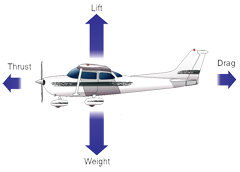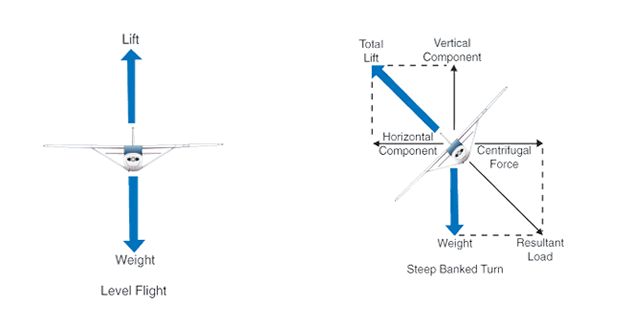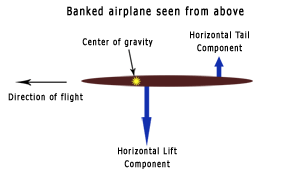THE MYSTERY OF TURNING FLIGHT
A standard question on any oral or written exam, be it for Private Pilot, Commercial or Instrument Rating, is "What makes an airplane turn?". The standard answer is short and easy: The horizontal component of lift. The only problem with this answer is that it is wrong – or at least very incomplete. I'll try to explain in a moment, first a little anecdote.
During an oral exam (I wont say to which certificate or rating) I got the standard question on turning flight and I was bold enough to attempt a non-standard answer. It went pretty much like this:
Examiner: "Tommy, explain to me what it is that makes an airplane turn."
Me: "Now this is an interesting question. In fact, it involves several factors working in unison..."
I got that far when I could sense all kinds of warning lights go off in the examiners head. I quickly changed course and gave the standard answer:
Me: "The horizontal component of lift created by rolling the airplane into a bank".
I passed the exam. I might not have if I had persisted with my answer – or maybe we would have had an interesting discussion about aerodynamics. We'll never know.
Some Background
 There are four forces acting on an airplane: thrust, drag, lift and gravity. If thrust is greater than drag, the airplane accelerates; If lift is greater than gravity (or weight as they tend to call it in aviation text books), the airplane gains altitude. In straight and level flight, at constant velocity, thrust equals drag and lift equals gravity (or weight), and the net force is zero.
There are four forces acting on an airplane: thrust, drag, lift and gravity. If thrust is greater than drag, the airplane accelerates; If lift is greater than gravity (or weight as they tend to call it in aviation text books), the airplane gains altitude. In straight and level flight, at constant velocity, thrust equals drag and lift equals gravity (or weight), and the net force is zero.
If we look closer at the lift vs. gravity (I'll start calling it weight to conform to the text books), it is clear that both lift and weight acts perpendicular to the wings, but in opposite directions. No force is acting in the horizontal direction and therefore nothing is pulling the airplane sideways. If we bank the airplane, the lift still acts perpendicular to the wings, while the weight is now acting at an angle to the wings (see the figures). The wings are of course at an angle relative to the horizon and one can separate the lift-vector in a vertical and an horizontal component. That is the famous horizontal component that is supposed to make an airplane turn.

The problem
The main problem with this scenario is that the horizontal component of lift simply pulls the airplane in the direction it is banked (you bank left, it pulls left and vice versa). If the pilot banks for a while and then straighten the wings parallel to the horizon, the nose should point in the same direction as before and the airplane should be on a course parallel to the original one – with the same heading. In short, there is no turning moment. Or if there is, it is in the 'wrong' direction (more about this further down).
To understand what is going on we must look at how an airplane is balanced in the longitudinal direction, that is in pitch. Like any see-saw, there are three components, two that pulls the airplane towards the ground and one that keeps it up. Balance is to make the three forces cancel each other.

As you can see, the horizontal stabilator is small wing turned up-side down. It creates lift directed downwards and helps balancing the airplane. The other downwards directed force is of course ol' gravity acting on the center of gravity of the airplane. For this to work, the center of gravity must be in front of the center of lift. As one can see from the picture of the airplane, the center of gravity and the center of lift are pretty close to each other, which is one reason why it is important to load an airplane according to the weight and balance restrictions. The tail down force is much smaller than the weight/gravity force. On the other hand the tail has a longer arm – think of the position of persons on a see-saw when their weights are very different.
So what really turns an airplane in flight
When the airplane is banked, the lift vector gets a horizontal component, and the tail down vector also gets a horizontal component. The latter is much smaller than the lift component but it has a longer arm and it is directed in the opposite direction. This creates a torque on the airplane but this is perfectly opposed by the horizontal component of lift associated with the banked wing. Again, the airplane simply makes a parallel move. However, the vertical component of lift is smaller than in level flight and in order to avoid losing altitude, the pilot has to compensate with a bit of back-pressure on the yoke. This increases both the lift and the horizontal components of the horizontal tail and makes the airplane pivot around the center of gravity. So it is actually the tail that pulls an airplane around in a turn. Remember the old saying that by pulling back on the yoke the nose goes up – at least initially. It's just that in this case the airplane is banked and the nose therefore moves in the direction of the bank.
 There are probably a few more subtleties involved in this (there always are). For instance, when an airplane is banked and moves sideways through the air (as in the parallel move discussed above), the relative wind will hit the airplane from the side it is banked towards. This will create a weather waning effect and since the surface area of an airplane usually is larger aft of the center of gravity, it will swing the airplane towards the relative wind. Since the airplane is still banked, this will just move the relative wind more and so on. This effect will act as long as the airplane is banked and help turn the airplane around the center of gravity. Another effect is that the center of lift and its horizontal component is situated aft of the center of gravity (as it should) and therefore creates a turning moment in the direction opposite of the bank. This is in addition to the adverse yaw induced by the increased drag on the low wing caused by the position of the ailerons during a bank. In a sense, the horizontal component of the lift causes the nose of the airplane to turn in the wrong direction. I am not sure how strong this effect is, but it ought to add to the adverse yaw.
There are probably a few more subtleties involved in this (there always are). For instance, when an airplane is banked and moves sideways through the air (as in the parallel move discussed above), the relative wind will hit the airplane from the side it is banked towards. This will create a weather waning effect and since the surface area of an airplane usually is larger aft of the center of gravity, it will swing the airplane towards the relative wind. Since the airplane is still banked, this will just move the relative wind more and so on. This effect will act as long as the airplane is banked and help turn the airplane around the center of gravity. Another effect is that the center of lift and its horizontal component is situated aft of the center of gravity (as it should) and therefore creates a turning moment in the direction opposite of the bank. This is in addition to the adverse yaw induced by the increased drag on the low wing caused by the position of the ailerons during a bank. In a sense, the horizontal component of the lift causes the nose of the airplane to turn in the wrong direction. I am not sure how strong this effect is, but it ought to add to the adverse yaw.
This concludes this section on turning flight. As you can see, there are several aspects of this that I wanted to discuss with the examiner, but fortunately didn't. Also, these are speculations by a non-aerodynamicist and anyone who may have something to add, refute, oppose or agree, please do contact me and tell me so. I'm still searching for the complete answer to why airplanes turn – maybe I should ask the examiner during my next check-ride...
